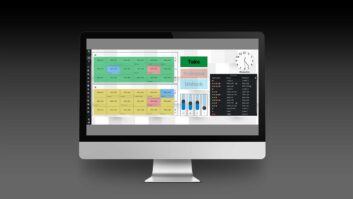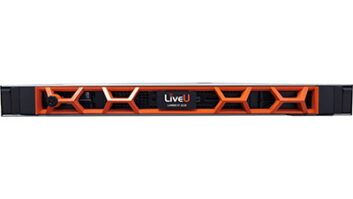
The last 12 months has seen a significant number of prestigious live events produced in 4K. The rapid take up of 4K cameras in the market combined with commercial availability of 4K production and recording technology has driven this trend. Against this background, what are the next significant developments that will bring technical, operational and commercial benefits to this exciting area of production?
Ahead of TVBEurope’s Beyond HD Masters conference, where he will be a keynote speaker, Claus Pfeifer – strategic marketing manager, live production, Sony Europe – explains the future importance of IP for 4K.
TVBEurope: To what extent has the industry already moved to video over IP?
Claus Pfeifer: Outside of news, where the contributions are rapidly moving to IP, we’ve already seen a lot of productions over IP where the technology is mostly used for distribution of content between a stadium venue and broadcaster or for remote contribution over an IP network between facilities across the Atlantic.
However IP in these scenarios is only used for distribution where it doesn’t matter if there is a delay of 1 or 2 seconds in transport. For production in and around a studio or between venues for live production you need very low latency. We need to send realtime video over IP with the same speed and latency as we do today with SDI otherwise the technology will not be adopted. For Sony this is key. We call it IP Live Production.
TVBEurope: In what way is the development of 4K and IP linked?
Pfeifer: IP and 4K depend on each other. The first trials of 4K production are all based on four times 3G HD-SDI cabling which is an expensive solution. To promote low-cost remote HD and 4K production across multiple venues we have to reduce the cost of implementing 4K in OB trucks and the most difficult challenge is the cost of cabling. SDI means one cable, one signal. With a 10 Gbit/s ethernet cable we can transmit six uncompressed full HD signals. For 4K to be practical in the future the industry has to have to move to 4K over IP.
With IP-based networks scalability is no problem. 40 Gbit/s and 100 Gbit/s ethernet exists today, even if we do not need them just yet. Resilience is also better with IP. It is much easier and cheaper to make an IP-based system highly-available without a single point of failure.
One problem is that while 4K 25p fits into existing standard 10 Gbit/s cable, 4K at 60p – which is required for live action sports – requires at least 12 Gbit/s or the use of low (mezzanine) compression. We don’t believe that codecs like JPEG 2000 or AVC deliver on the extreme low latency required of live production which is why Sony has developed a proprietary low latency video codec. This is derived from the same codec used in our HSC studios cameras and digital triax connections. It is very good and is resilient over multiple generations.
TVBEurope: What technology is Sony developing in this area?
Pfeifer: Last year Sony introduced the NXL-IP55 as the first step in its quest for IP transmission. This permits the multiplexing of four HD signals over gigabit Ethernet cable at 1 Gbps. From 2015 Sony will introduce IP packet transmission directly to many of its devices. The camera CCU will have an IP interface so that users can choose between SDI and IP and then connect the CUU to an IP based router.
We do not intend to build our own IP routers. This is not our core competency. Instead we will connect with standard off-the-shelf routers, from Juniper or Cisco, for example. We can build cheaper infrastructure through the use of commodity IT kit instead of dedicated SDI routing equipment and cabling. We will ensure broadcast quality however with equipment we have built which interfaces with commodity IP kit. A IP Live System Manager will monitor Quality of Service levels. We intend that all our products from monitors, and servers to switchers will have IP connectivity in the near future.
For those devices that cannot be retrofitted straight away or easily, we have small portable conversion boxes to convert IP to HD-SDI or the other way around. These modules are set for release by the end of 2014.
TVBEurope: How are you working with the EBU/SMPTE/VSF Joint Task Force on Networked Media (JT-NM) to standardise video over IP?
Pfeifer: Sony has proposed a couple of technologies to that taskforce and so is very open about standardisation. We are taking the bricks of existing standards and combining them slightly differently. Our technology will be compatible with SMPTE 2022-6 [a specification for transporting uncompressed HD-SDI under review at the JT-NM] and with IEEE1558 [a precision time protocol for genlocking devices over IP]. Additional features such as compression are not being defined by the standards. We are being very open to the industry about offering this technology and believe a similar process will happen to that of the development of SDI, which was also an initiative of Sony and which became universally adopted. The same must happen with IP live.
TVBEurope: What are the next steps?
Pfeifer: We are talking to all our key broadcast customers around Europe about their roadmaps for moving into a pure IP world. Our first products will launch by end of this year and just before that or at the beginning of next year we’ll conduct some tests with major broadcast customers.
Claus Pfeifer will be presenting a special Sony session that will address the challenges of transporting 4K video over IP and the future migration to IP production. Sony has been a pioneer in 4K production. Recent production trials in which Sony has participated have been the live 4K broadcast of War Horse and the transmission of the canonisation of Popes John Paul II and John XXIII from the Vatican.
TVBEurope’s Beyond HD Masters conference takes place on June 3 at BAFTA Piccadilly. Tickets are still available at: www.beyondhdmasters.com







